Breeder Game Jolt Page: http://gamejolt.com/games/breeder/43356
Breeder: Homegrown Game Jolt Page: http://gamejolt.com/games/breeder-homegrown/63826
Breeder itch.io Page: https://outlands.itch.io/breeder
Breeder: Homegrown itch.io Page: https://outlands.itch.io/breeder-homegrown
Developer’s Website: http://www.outlands-games.com/
It’s not particularly scary and it’s rarely all that graphic, but I will forever be a fan of Lovecraftian cosmic horror. What it lacks in actual spookiness it makes up for in spades with raw atmosphere, with a sense of mystery mixed with a subtle, uncanny valley-style feeling of ‘wrongness’. Breeder and especially its semi-sequel Breeder: Homegrown capture this atmosphere wonderfully well and make for great, short additions to a genre largely founded upon great short stories.
The comparison between these games and short stories applies to more than just their durations. Yes, they’re each only about half an hour long, and the first game is much shorter than the second, but they are also very much ‘stories’ with little in the way of what most people would probably consider traditional gameplay. Other than some extremely light puzzle solving, the bulk of each game consists of exploring the environment and interacting with other characters. It’s also worth noting that these games are self-contained stories; they take place in the same universe as each other in roughly the same time period and definitely share some narrative similarities, but the characters otherwise have nothing to do with each other.

The first game takes place across three generations of the Carr family. You can freely choose between playing as Jacob, Marty, or Eva, all nine years old and living in the years 1951, 1987, and 2020 respectively. Regardless of which character you decide to pick, you’ll immediately be confronting with an ominous, ambient drone and a ‘house’ in the form of a glowing blue floorplan with basic outlines defining doors, walls, and interactive objects and labels for each room. The stark contrast between the character and their surroundings immediately invokes that sense of uneasy wrongness and it is especially effective when paired with the ambient sounds and the fact that even the parents are merely circles labelled “mother” and “father” as though they are also just another part of the house.
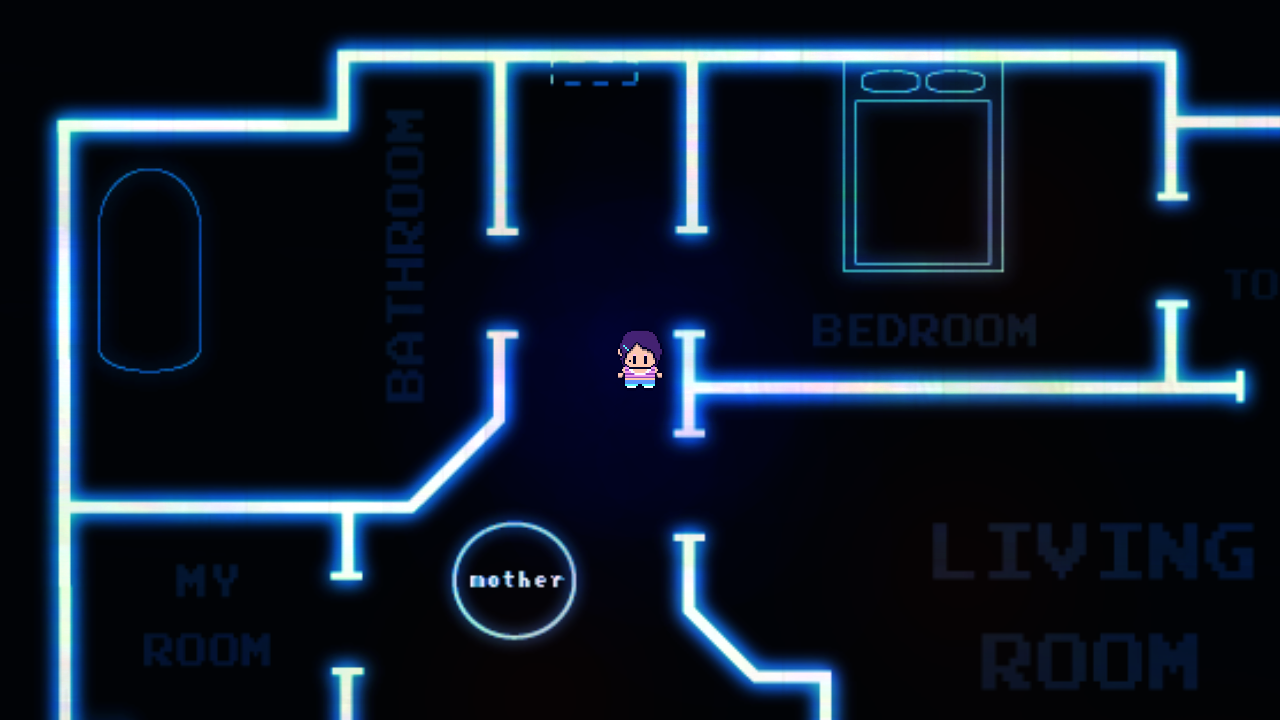
Most of your time is going to be spent playing as Marty. You see, there is a secret in this house, a hidden place underneath it which Jacob refers to as “the labyrinth”. Jacob is unwilling to enter it as he has already done so in the past and has no desire to do so again and Eva is incapable of entering it as Marty, now reduced to a mute “father” circle, has sealed it with cement. As Marty is both ignorant of just what the labyrinth is and capable of entering it simply by removing a few loose floorboards in his closet, he is the only character within the confines of the story who steps beyond the normal bounds of the house. This is not to say that choosing to play as Eva or Jacob is pointless, but rather that their arcs are supplemental as both of them provide more insight into the nature of the labyrinth and how its presence affects the family and, from a gameplay perspective, each provides a clue necessary to get through the labyrinth without resorting to tediously brute forcing solutions.
Just what is the labyrinth? I won’t go too far into specifics since travelling through the labyrinth is one of the most interesting parts of Breeder, but there are a few things worth noting. As the name implies, the labyrinth is a maze-like area and it is represented through outlines just like the house is. In fact, the outline of the house makes up parts of the background to create a particularly disorienting sensation as Marty is able to walk over the outlines of furniture; outlines which once served as representations of three-dimensional objects are now merely actual outlines on the floor. The labyrinth taking on the same simplistic style as the house can initially be somewhat disappointing as it means players never get a real look at some of the strange sights Marty describes, but I think the style ultimately serves to strengthen the final parts of Marty’s journey.

Before moving on to the second game, I do want to give a final word of warning about the ending. Though I do not personally consider this a downside to the game, it does end rather abruptly in traditional cosmic horror fashion and only leaves more questions than answers. Don’t go into this game looking forward to finding out the answers to all the questions it poses because it’s not going to provide all that many of them, but it does make for a fascinatingly strange and short journey along the way.
Breeder: Homegrown shares many similarities with its predecessor, but it is also quite different. Like the first game, this one takes place within a single house (and the backyard) across a few decades in roughly modern times. Also like in the first game, this is primarily a story about a family and their secrets, though both the characters and the nature of said secrets are far more fleshed out this time around. You’re still not going to get all the answers and there’s still not really much at all in the way of anything scary or particularly involved gameplay-wise, though I’d say this is definitely the better of the two games.
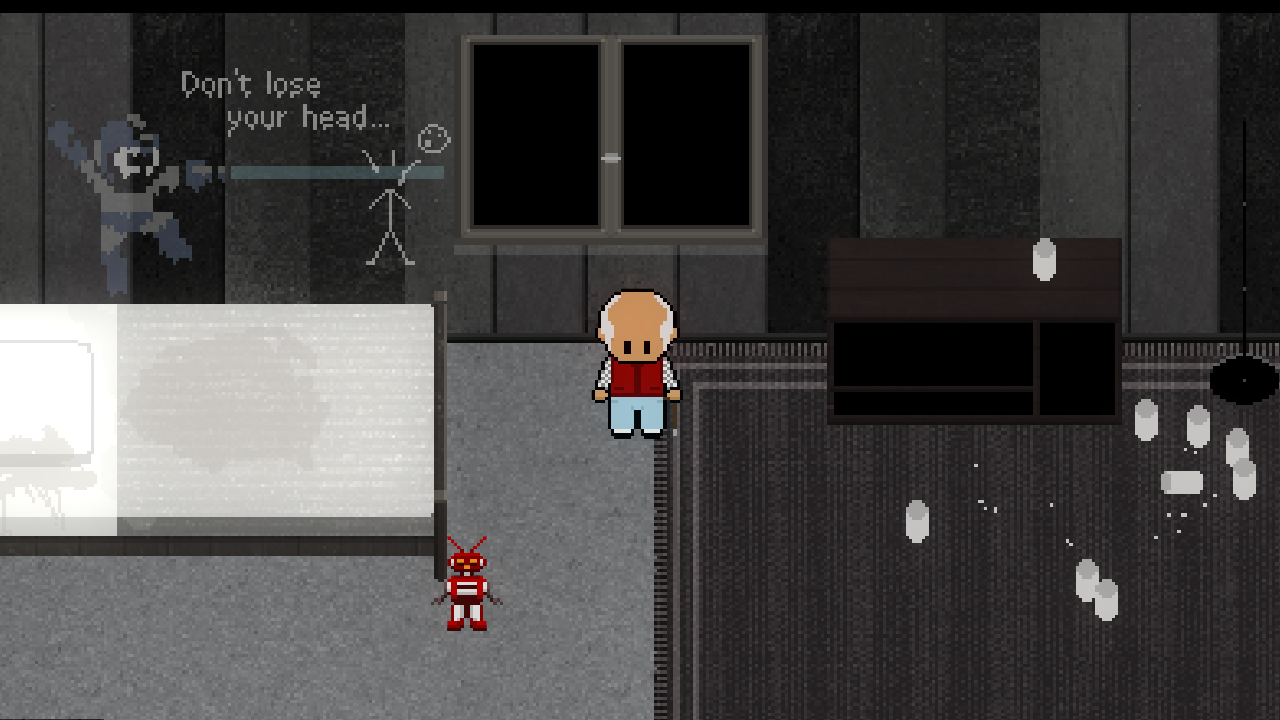
Let’s start looking at the differences. The most obvious of these is definitely in the aesthetics department. The abstract floorplan style from the first game is completely gone in favor of more homogeneous spritework. This more ordinary look is fine since this entry focuses more on minor details which would have been lost or trivialized in the original style, but the camera feels like it’s zoomed in too much to the point where it can be easy to initially mistake the tiles of the kitchen floor for a wall. You also have access to an inventory, somewhat annoyingly tied to the ‘I’ key, but there is never a need to open it other than for small pieces of flavor text and for some reason the game becomes silent while it is open so it ultimately comes across as a rather pointless addition which the game could have done without. The other major difference here is that you’re only taking on the role of a single character, David, this time around, both as a child and as an old man.
The story begins with David as an old man who has recently escaped from a hospital to visit his old house, which is now in a state of disrepair. Much of the house is covered in graffiti which more often than not is rather silly (there’s even some spritework of Mega Man on one of the walls), but this might actually be deliberate as the game takes place from David’s perspective and he does not come across as the most sane, let alone most reliable, of narrators to the point that it is questionable if the house even still exists.
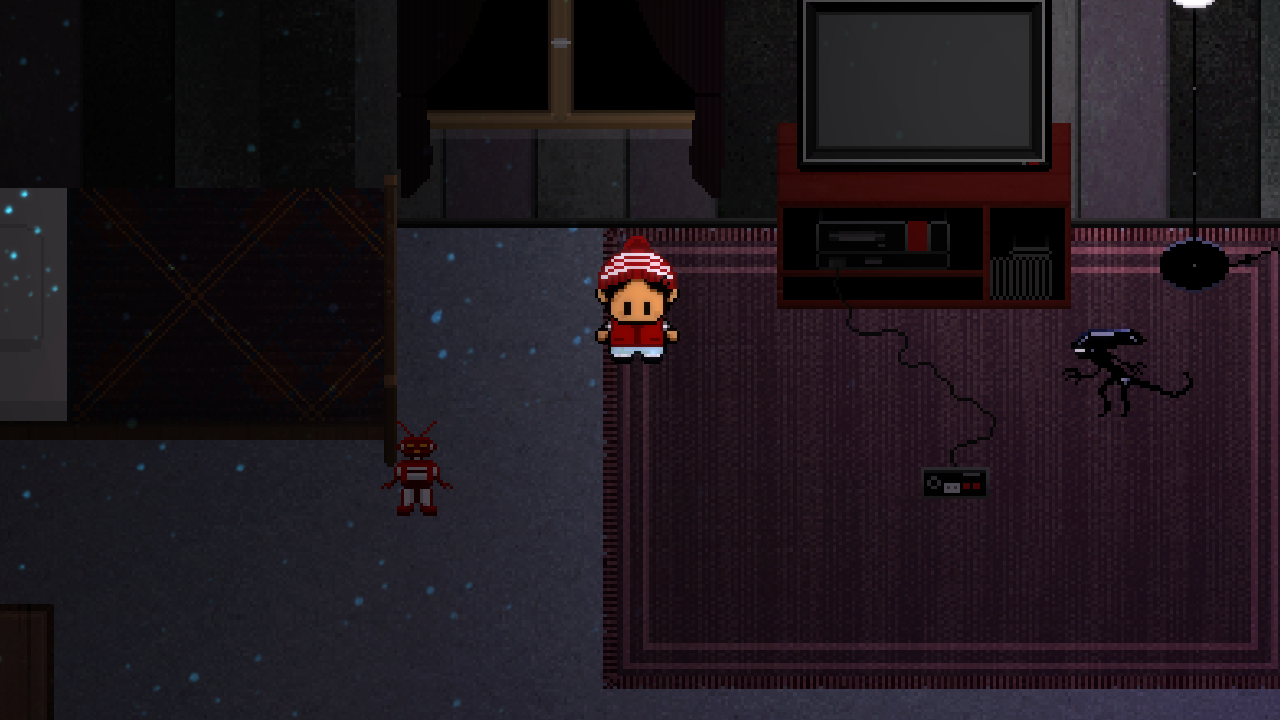
Possibly my favorite part of this game’s narrative is its more freeform nature. As an old man, David can wander around the house and interact with four different locations in any order to recall the past. These memories are where the majority of the game actually takes place. Within them, you control David as a kid in, judging by the NES in his room, the late 1980’s or early 1990’s, as he interacts with his father, his stepmother, and his rather mysterious “buddy”. The exact length of each of these scenes varies by a fairly wide margin, but they work together to form a cohesive plot and each presents its own mysteries and answers so the story remains engaging regardless of the order in which the events are approached.
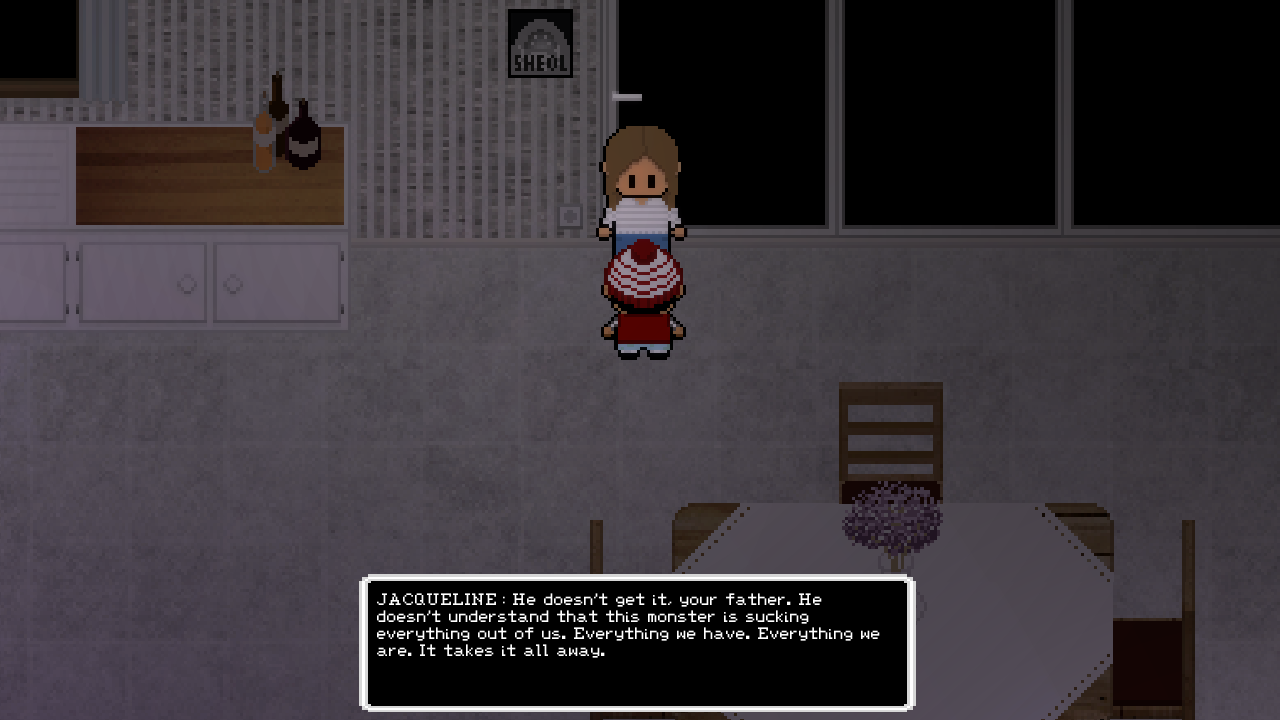
There are also a lot of little details in Breeder: Homegrown which really make it stand out for me. For example, David as an old man won’t specify when the events take place, but you can piece together the order of the events and even how far apart they are from each other by examining a book in David’s room when he is a child as doing so will make David comment on the current month. There’s also a background story involving David’s biological mother which gradually gets revealed in a set order after each memory, so some of the biggest reveals are saved for the end no matter which order you choose. Quirks like David moving much faster as a child than as an old man and oddities like David being absolutely unrelenting on brushing his teeth three times a day like his mother told him to (the toothbrush is even one of your few inventory items) further enhance the story.
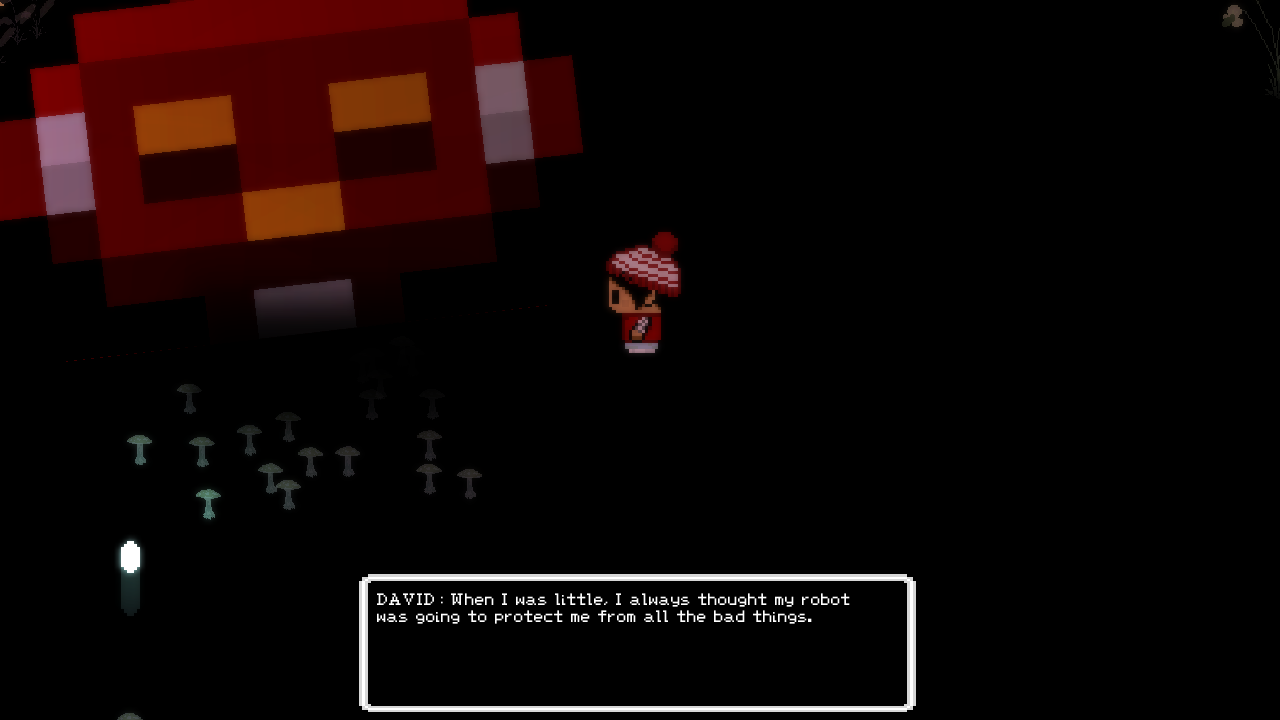
While I would take the second game over the first, the truth is that I think both of these games are great and embody the best parts of cosmic horror. I’ve tried to avoid going too far into specifics over the course of this article since these are narrative-focused games which are short enough that you could probably finish them back-to-back in under an hour, but you can check out the video at the start of this article (if you haven’t already done so) if you want to get a better idea of the overall tone, atmosphere, and pacing in this series. There is also a third game in development with a much longer estimated playtime (10+ hours), so that is certainly worth keeping an eye on if you enjoy these shorter excursions into this bizarre universe.